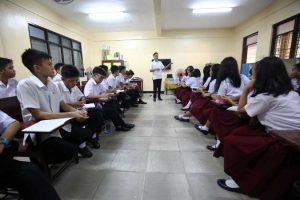By Alyssa Nicole O. Tan, Reporter
THE COUNTRY’s so-called learning poverty could spur a workforce crisis if not resolved soon, according to education experts.
“If learning poverty in the country will not be urgently addressed, our future human resources will be a major challenge to our economic development,” Jerome T. Buenviaje, dean of the University of the Philippines College of Education said in an e-mail.
“This simply means producing a generation whose skills are not aligned with the need of our country,” he said, noting that the country relies a lot on the service economy, which requires 21st-century learning skills.
The Philippines’ learning poverty is among the highest in the region, with nine of 10 Filipinos unable to read and understand short, age-appropriate texts by the age of 10, according to the World Bank. It added that 5% of children who should be in primary school are not enrolled.
“Reading is the gateway to learning,” Philippine Business for Education Acting Executive Director Justine B. Raagas said in a Viber message. “It is a basic skill that makes all other learning possible, and it is a basic skill needed for an individual to progress in school and join the workforce.”
“Our learners would not be able to build a better career if they have poor literacy skills,” he added.
One of two Filipino workers did not finish high school, Mr. Raagas said, citing a labor force survey in June. The lack of basic competencies and qualifications translated to a high underemployment rate.
About 5.8 million Filipinos were working in low-skilled positions with inadequate pay. “An educated workforce means shared economic prosperity for everyone,” he added.
Mr. Buenviaje said all education levels are important, but basic education should be prioritized for budget allocations. “This is where the biggest number of learners belong.”
“Budget allocations should prioritize the improvement of learning environments, organizational development, learning material production and keeping the health and well-being of all stakeholders,” he said.
The government should aim to build a stronger education system that will help it achieve its quality education agenda and other sustainable development goals, he added.
Mr. Raagas said he agreed with the government’s decision to allot about 80% of the education sector’s budget for the salaries and benefits of teachers.
“A low-hanging fruit is to reduce administrative work from teachers so that they can focus on improving themselves and their instruction,” he said. “In the mid-term, we must ensure that we increase their capacity and quality by providing them with better skill training.”
The government of President Ferdinand R. Marcos, Jr. has said the coronavirus pandemic would no longer become an excuse to suspend face-to-face classes.
Vice-President Sara Duterte-Carpio, who serves as Education secretary, rejected calls to move the opening of school day to September or October.
Mr. Raagas said the vice-president should use her political capital to improve the educational system. “The convergence of tools, resources, networks, and technical expertise from the education and private sector is needed to address our country’s learning crisis.”
He also cited the need to make the education sector more autonomous, noting that local governments and schools should be held accountable.
“Studies show that students in countries with greater school autonomy tend to perform better. Their autonomy covers what and how students are taught and how they are assessed.” Local governments should also play a larger role and work with local school systems.
Mr. Buenviaje said state efforts to handle the education crisis are at an early stage and could be improved further.
He called for a whole-government approach where different agencies work with the Department of Education to come up with effective policies. “It is also important to make schooling attractive to learners, parents and other stakeholders.”
“The active participation of local government units and the influence of mainstream and social media can be used to promote back-to-school campaigns and other programs that will increase school enrollment,” he added.

